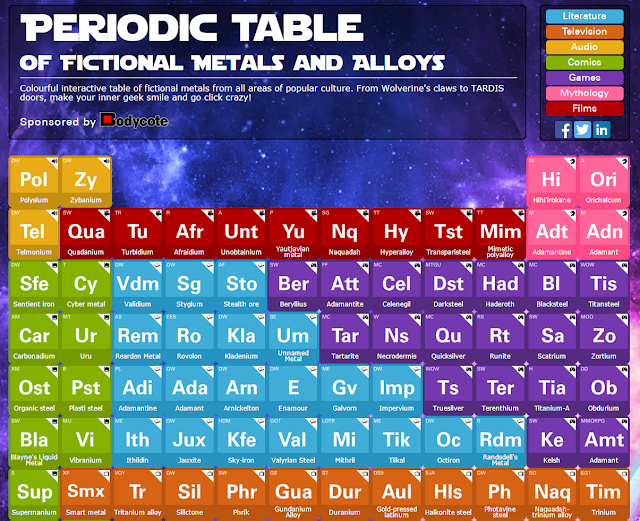A guy named Jim Seward reached out to me about my post on "Fictional Metals," which can be found HERE. In that post I talk about several metals that are used in comic books. I have another related post found HERE that speaks about my own use of fictional metals in my science fiction/fantasy books. Anyway, Jim wrote, "I read your piece on fictional metals with interest and thought you might enjoy THIS, which is an interactive periodic table of fictional metals, it’s a recently completed content piece by Bodycote, an international metal heat treater and I was wondering whether you would like to feature it on your blog as it seems to be a good match for your audience. Attached is a press release and some images for your use."
I pasted the image below, but you can follow the link embedded above to the table and click on it. It's pretty cool (if you have the time and interest to do so).
June 2016
BODYCOTE SPONSORS THE PERIODIC TABLE OF FICTIONAL METALS
Materials treatment company takes interactive look at fantastical metals
MACCLESFIELD (U.K.) — Creative people have long invented metals with mythical or magical qualities. Fictional metals have appeared in classical myths, books, films, comics and computer games for many years.
Bodycote has a long history of working with various metals to increase their performance and meet their customers’ requirements. Sometimes, though, in the myriad worlds of fiction, real metals just don’t do what the author needs. The idea to research fictional metals was inspired by a heat treatment request to case harden Mjolnir (Thor’s hammer); however no one could pick it up to load it in to the furnace.
Popular culture has given us an extensive list of metals and alloys with fantastical qualities. In addition to Marvel Comics, whose ‘vibranium’ and ‘adamantium’ are probably some of the best known due to recent cinematic releases, fictional metals have appeared in popular science fiction like Star Trek, Star Wars and Doctor Who, TV shows such as Game of Thrones and the X Files, literature like the Lord of The Rings and video games such as the popular Minecraft franchise.
Explore all these fascinating materials and many more in the Interactive Periodic Table of Fictional Metals. Visit the Interactive Periodic Table of Fictional Metals at http://www.bodycote.com/fictional-metals
- Ends -
About Bodycote
With more than 170 accredited facilities in 21 countries, Bodycote is the world’s largest provider of thermal processing services. Through heat treatment, metal joining, surface technology and Hot Isostatic Pressing (HIP), Bodycote improves the properties of metals and alloys, extending the life of vital components for a wide range of industries, including aerospace, defence, automotive, power generation, oil & gas, construction, medical and transportation. Customers in all of these industries have entrusted their products to Bodycote’s care for more than 30 years. For more information, visit www.bodycote.com.
For further information, please contact:
Jim Seward | Inbound Marketing Manager



That table could come in handy.
ReplyDeleteSounds fascinating.
ReplyDeleteWhen I watch Jeopardy and the category is the Periodic Table I get up and go to the fridge. I never memorized the Periodic Table, so I wouldn't know which ones are fictional. Maybe someday I'll learn them.
ReplyDeleteSadly, between my ignorance of scientific details in sci fi and fantasy fiction (even though I'm a Star Trek and Star Wars fan), I would look at this table and figure some of these metals are real, and then look at the periodic table and figure some of them were fiction.
ReplyDeleteThis is why I write historical fiction. I'm not smart enough for the science stuff (and The Martian really proved this to me).
That's really cool.
ReplyDeleteI favorited this to look at later. This could come in quite handy. Thanks Mike.
ReplyDelete